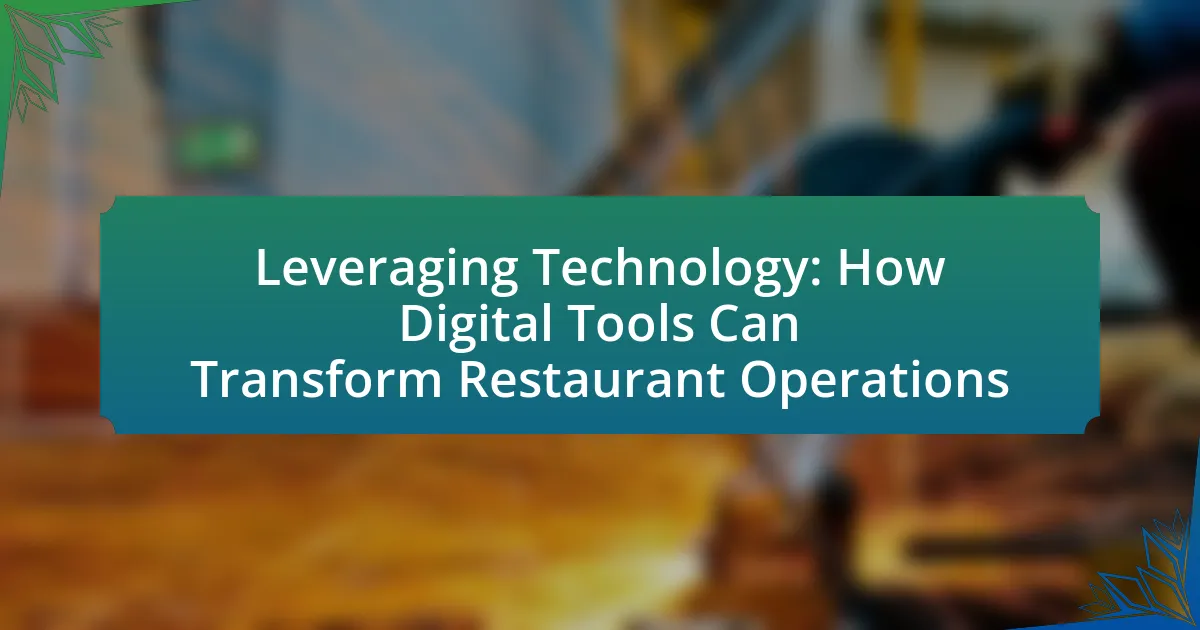The article focuses on maximizing profit margins in the restaurant industry through effective cost control strategies. Key factors influencing profit margins include food costs, labor costs, pricing strategies, and operational efficiency. It discusses the impact of food costs on profitability, strategies for managing these costs, and the importance of labor cost optimization through scheduling and cross-training. Additionally, the article highlights the significance of managing overhead costs, implementing waste reduction strategies, and utilizing technology for inventory management. Best practices for creating a culture of cost awareness among staff and conducting regular financial reviews are also examined, providing actionable insights for restaurant owners to enhance their financial performance.

What are the key factors influencing profit margins in restaurants?
Key factors influencing profit margins in restaurants include food costs, labor costs, pricing strategies, and operational efficiency. Food costs typically account for a significant portion of expenses, often ranging from 25% to 35% of total sales, making effective inventory management and supplier negotiations crucial for maintaining margins. Labor costs, which can represent 30% to 40% of total expenses, require careful scheduling and training to optimize productivity and minimize overtime. Pricing strategies, including menu design and perceived value, directly impact revenue; restaurants that regularly analyze competitor pricing and customer preferences can adjust their offerings to enhance profitability. Lastly, operational efficiency, encompassing waste reduction and streamlined processes, can significantly improve profit margins by lowering overhead costs.
How do food costs impact overall profitability?
Food costs significantly impact overall profitability by directly influencing the cost of goods sold (COGS) and, consequently, the gross margin. When food costs rise, the percentage of revenue allocated to purchasing ingredients increases, which can reduce the profit margin if menu prices remain unchanged. For instance, if a restaurant’s food cost percentage is 30% and it increases to 35%, the restaurant must either raise prices or find ways to cut costs elsewhere to maintain profitability. According to the National Restaurant Association, food costs typically account for about 28-35% of total sales in the restaurant industry, highlighting their critical role in determining profitability.
What strategies can be implemented to manage food costs effectively?
To manage food costs effectively, restaurants can implement strategies such as inventory management, menu engineering, and supplier negotiation. Inventory management involves tracking stock levels and usage rates to minimize waste and ensure timely ordering, which can reduce costs by up to 15% according to the National Restaurant Association. Menu engineering focuses on analyzing the profitability and popularity of menu items, allowing restaurants to adjust offerings to maximize margins. Additionally, negotiating with suppliers for better pricing or bulk purchasing can lead to significant savings, as evidenced by a study from the Food Marketing Institute, which found that effective supplier relationships can lower food costs by 10-20%.
How does portion control affect food costs?
Portion control directly reduces food costs by minimizing waste and ensuring consistent serving sizes. When restaurants implement portion control, they can accurately predict ingredient usage, leading to better inventory management and reduced over-purchasing. According to a study by the National Restaurant Association, effective portion control can lower food costs by up to 10%, as it helps maintain consistent pricing and reduces the likelihood of spoilage. This practice not only enhances profitability but also improves customer satisfaction by providing consistent meal experiences.
What role does labor cost play in restaurant profitability?
Labor cost significantly impacts restaurant profitability by directly influencing the overall operating expenses. High labor costs can erode profit margins, as they account for a substantial portion of total expenses, often ranging from 25% to 40% of revenue. Efficient management of labor costs, including optimizing staff schedules and minimizing overtime, can enhance profitability by ensuring that labor expenses align with sales volume. For instance, a study by the National Restaurant Association indicates that restaurants with effective labor cost control strategies can improve their profit margins by up to 10%. Thus, controlling labor costs is essential for maintaining a healthy bottom line in the restaurant industry.
How can scheduling optimize labor costs?
Scheduling can optimize labor costs by ensuring that staffing levels align with customer demand, thereby reducing unnecessary labor expenses. Effective scheduling allows restaurants to deploy employees during peak hours when customer traffic is high and minimize staffing during slower periods. According to a study by the National Restaurant Association, proper scheduling can lead to a reduction in labor costs by up to 10% by avoiding overstaffing and ensuring that labor hours are used efficiently. This strategic approach not only enhances operational efficiency but also contributes to improved profit margins.
What are the benefits of cross-training staff?
Cross-training staff enhances operational efficiency and flexibility in restaurants. By equipping employees with multiple skills, restaurants can better manage labor costs and adapt to fluctuating customer demands. For instance, a study by the National Restaurant Association indicates that cross-trained employees can reduce staffing shortages by up to 30%, allowing for smoother service during peak hours. Additionally, cross-training fosters teamwork and improves employee morale, as staff members feel more valued and engaged in their roles. This holistic approach not only streamlines operations but also contributes to higher customer satisfaction and retention, ultimately maximizing profit margins.
How do overhead costs affect profit margins?
Overhead costs negatively impact profit margins by increasing the total expenses a restaurant incurs, which reduces the amount of revenue available for profit. When overhead costs, such as rent, utilities, and administrative expenses, rise, they consume a larger portion of the restaurant’s income. For instance, if a restaurant’s overhead costs account for 30% of its revenue, any increase in these costs directly diminishes the profit margin, as the remaining 70% must cover food costs, labor, and other variable expenses. This relationship highlights the importance of managing overhead costs effectively to maintain or improve profit margins in the competitive restaurant industry.
What are common overhead expenses in restaurants?
Common overhead expenses in restaurants include rent, utilities, insurance, and payroll. Rent typically represents a significant portion of a restaurant’s fixed costs, often ranging from 5% to 10% of total sales. Utilities, which encompass electricity, water, and gas, can account for about 3% to 5% of sales. Insurance costs, including liability and property insurance, generally range from 1% to 3% of total revenue. Payroll, which includes wages for staff and management, is usually the largest expense, often comprising 25% to 35% of total sales. These expenses are crucial for maintaining operations and directly impact profit margins.
How can energy efficiency reduce overhead costs?
Energy efficiency can significantly reduce overhead costs by lowering utility expenses associated with energy consumption. Implementing energy-efficient appliances and systems, such as LED lighting and high-efficiency HVAC units, can decrease electricity and gas bills by up to 30%, as reported by the U.S. Department of Energy. Additionally, energy-efficient practices can extend the lifespan of equipment, reducing maintenance and replacement costs. By minimizing energy waste, restaurants can allocate resources more effectively, ultimately enhancing profit margins.

What are effective cost control strategies for restaurants?
Effective cost control strategies for restaurants include implementing inventory management systems, optimizing menu pricing, and reducing food waste. Inventory management systems help track stock levels and usage rates, allowing restaurants to order supplies more efficiently and minimize excess. Optimizing menu pricing involves analyzing food costs and customer preferences to set prices that maximize profit margins while remaining competitive. Reducing food waste can be achieved through portion control, proper storage techniques, and utilizing leftover ingredients creatively, which not only lowers costs but also enhances sustainability efforts. These strategies collectively contribute to improved financial performance in the restaurant industry.
How can menu engineering enhance profitability?
Menu engineering enhances profitability by strategically analyzing and designing a restaurant’s menu to optimize item placement, pricing, and descriptions. This approach allows restaurants to identify high-margin items and promote them effectively, leading to increased sales of profitable dishes. For instance, research by the Cornell University School of Hotel Administration found that menu layout and item positioning can significantly influence customer choices, with well-engineered menus increasing sales by up to 15%. By focusing on the profitability of each menu item and adjusting based on performance data, restaurants can maximize their overall profit margins.
What factors should be considered in menu pricing?
Menu pricing should consider food costs, labor costs, market demand, competition, and perceived value. Food costs represent the direct expenses associated with ingredients, which should ideally be around 30% of the menu price to maintain profitability. Labor costs include wages and benefits for staff, which can significantly impact overall pricing strategies. Market demand influences how much customers are willing to pay, often requiring adjustments based on trends and customer preferences. Competition necessitates an analysis of similar offerings in the area to ensure prices remain attractive while still profitable. Lastly, perceived value relates to how customers view the quality and experience of the meal, which can justify higher prices if effectively communicated.
How can item popularity and profitability be analyzed?
Item popularity and profitability can be analyzed through sales data and customer feedback. Sales data provides quantitative metrics such as the number of units sold, revenue generated, and profit margins for each menu item, allowing restaurants to identify which items are most popular and financially beneficial. Customer feedback, gathered through surveys or reviews, offers qualitative insights into consumer preferences and satisfaction levels, helping to contextualize the sales figures. For example, a study by the National Restaurant Association found that menu items with higher customer ratings often correlate with increased sales, reinforcing the importance of both data types in analysis.
What inventory management techniques can be utilized?
Effective inventory management techniques that can be utilized include Just-In-Time (JIT) inventory, ABC analysis, and inventory turnover ratio optimization. JIT inventory minimizes holding costs by ordering stock only as needed, which is particularly beneficial for perishable goods in restaurants. ABC analysis categorizes inventory into three classes (A, B, and C) based on their importance and value, allowing restaurants to focus on managing high-value items more closely. Inventory turnover ratio optimization measures how quickly inventory is sold and replaced, helping restaurants identify slow-moving items and adjust purchasing strategies accordingly. These techniques are proven to enhance efficiency and reduce waste, ultimately contributing to improved profit margins in the restaurant industry.
How does regular inventory auditing contribute to cost control?
Regular inventory auditing significantly contributes to cost control by identifying discrepancies between recorded and actual inventory levels, which helps prevent overstocking and stockouts. This process allows restaurants to maintain optimal inventory levels, reducing waste and minimizing holding costs. For instance, a study by the National Restaurant Association found that effective inventory management can reduce food costs by up to 10%. By regularly auditing inventory, restaurants can also enhance their purchasing decisions, ensuring they buy only what is necessary, thus further controlling costs and maximizing profit margins.
What technology can assist in inventory management?
Technologies that assist in inventory management include inventory management software, barcode scanning systems, and RFID technology. Inventory management software enables real-time tracking of stock levels, automating reordering processes, and providing analytics for better decision-making. Barcode scanning systems streamline the process of tracking inventory by allowing quick updates and accurate data entry. RFID technology enhances inventory accuracy and visibility by using radio waves to automatically identify and track items. These technologies collectively improve efficiency, reduce waste, and help maintain optimal stock levels, which are crucial for maximizing profit margins in restaurants.
How can waste reduction strategies improve profit margins?
Waste reduction strategies can improve profit margins by minimizing costs associated with excess materials and inefficiencies. By implementing practices such as inventory management, portion control, and recycling, restaurants can significantly lower their food waste, which directly reduces expenses. For instance, a study by the Food Waste Reduction Toolkit indicates that restaurants can save up to 20% on food costs by effectively managing waste. This reduction in costs enhances overall profitability, as less money is spent on purchasing unnecessary supplies, leading to improved financial performance.
What are effective methods for tracking and reducing food waste?
Effective methods for tracking and reducing food waste include implementing inventory management systems, utilizing waste tracking software, and adopting portion control practices. Inventory management systems help restaurants monitor stock levels and expiration dates, reducing the likelihood of spoilage. Waste tracking software allows establishments to analyze waste patterns, identifying specific items that contribute to excess waste, which can inform purchasing decisions. Additionally, portion control practices ensure that servings are consistent, minimizing leftovers and uneaten food. According to the Food Waste Reduction Toolkit by the USDA, restaurants can reduce food waste by up to 30% through these strategies, leading to significant cost savings and improved profit margins.
How can staff training contribute to waste reduction?
Staff training can significantly contribute to waste reduction by equipping employees with the knowledge and skills necessary to minimize resource usage and optimize operational efficiency. When staff members are trained on proper portion control, food storage techniques, and waste management practices, they are more likely to implement these strategies effectively. For instance, a study by the Food Waste Reduction Alliance found that restaurants that trained their staff on waste reduction practices reduced food waste by up to 30%. This training not only fosters a culture of sustainability but also leads to cost savings, as less waste translates to lower disposal costs and improved profit margins.

What are the best practices for implementing cost control strategies?
The best practices for implementing cost control strategies in restaurants include establishing a detailed budget, monitoring expenses regularly, and utilizing inventory management systems. A detailed budget provides a clear financial framework, allowing restaurant managers to allocate resources effectively and identify areas for cost reduction. Regular monitoring of expenses helps in identifying variances from the budget, enabling timely corrective actions. Utilizing inventory management systems ensures that food and beverage costs are tracked accurately, reducing waste and optimizing purchasing decisions. According to a study by the National Restaurant Association, effective cost control can improve profit margins by up to 10%, highlighting the importance of these practices in maximizing profitability.
How can restaurants create a culture of cost awareness?
Restaurants can create a culture of cost awareness by implementing regular training sessions focused on financial literacy for all staff members. This approach ensures that employees understand the impact of their actions on the restaurant’s overall profitability. For instance, a study by the National Restaurant Association found that restaurants that invest in employee training see a 20% increase in productivity, which directly correlates with better cost management. Additionally, establishing clear communication channels for sharing cost-related information, such as food waste statistics and labor costs, fosters a sense of accountability among staff. By integrating these practices, restaurants can effectively cultivate a culture where cost awareness is prioritized and embedded in daily operations.
What training programs can be developed for staff?
Training programs that can be developed for staff in restaurants include customer service training, food safety and hygiene training, inventory management training, and cost control training. Customer service training enhances staff interaction with patrons, leading to improved customer satisfaction and repeat business, which is crucial for maximizing profit margins. Food safety and hygiene training ensures compliance with health regulations, reducing the risk of foodborne illnesses and potential legal issues. Inventory management training teaches staff how to track and manage stock effectively, minimizing waste and optimizing purchasing decisions. Cost control training equips employees with strategies to reduce expenses and improve operational efficiency, directly impacting profit margins. These training programs are essential for creating a knowledgeable and efficient workforce that contributes to the overall success of the restaurant.
How can management communicate cost control goals effectively?
Management can communicate cost control goals effectively by utilizing clear, consistent messaging and engaging employees in the process. This involves setting specific, measurable objectives that align with the overall financial targets of the restaurant, ensuring that all staff understand their roles in achieving these goals. For instance, regular training sessions and meetings can reinforce the importance of cost control, while visual aids like charts and dashboards can track progress and highlight areas needing improvement. Research indicates that organizations with transparent communication strategies see a 25% increase in employee engagement, which directly correlates to better adherence to cost control measures.
What tools and technologies can support cost control efforts?
Cost control efforts in restaurants can be effectively supported by tools and technologies such as restaurant management software, inventory management systems, and financial analytics platforms. Restaurant management software, like Toast or Square, streamlines operations by integrating point-of-sale systems with inventory tracking, enabling real-time monitoring of sales and costs. Inventory management systems, such as BlueCart or MarketMan, help track ingredient usage and waste, allowing for better purchasing decisions and reducing food costs. Financial analytics platforms, like QuickBooks or Xero, provide insights into financial performance, helping restaurant owners identify areas for cost reduction and improve overall profitability. These tools collectively enhance operational efficiency and provide actionable data to support informed decision-making in cost control.
How can point-of-sale systems aid in cost tracking?
Point-of-sale systems aid in cost tracking by providing real-time data on sales, inventory, and expenses. These systems automatically record each transaction, allowing restaurant managers to analyze sales patterns and identify cost fluctuations. For instance, they can track the cost of ingredients used in menu items, enabling precise calculation of food costs and profit margins. Additionally, point-of-sale systems often integrate with accounting software, streamlining financial reporting and enhancing visibility into overall operational costs. This integration facilitates better decision-making regarding pricing strategies and inventory management, ultimately contributing to improved profitability.
What role does data analytics play in cost management?
Data analytics plays a crucial role in cost management by enabling restaurants to identify, analyze, and optimize their expenses. Through the examination of historical data, restaurants can pinpoint areas of overspending, such as food waste or labor inefficiencies, and implement targeted strategies to reduce these costs. For instance, a study by the National Restaurant Association found that data-driven decision-making can lead to a 10-15% reduction in operational costs. By leveraging data analytics, restaurants can also forecast demand more accurately, allowing for better inventory management and minimizing excess stock, which further contributes to cost savings.
What practical tips can restaurants follow to maximize profit margins?
Restaurants can maximize profit margins by implementing effective cost control strategies. One practical tip is to optimize menu pricing based on food cost percentages, ensuring that each dish contributes adequately to overall profitability. For instance, maintaining a food cost percentage between 28% to 35% allows for a healthy margin while remaining competitive.
Another strategy is to reduce food waste through inventory management and portion control, which can save up to 10% of food costs. Additionally, negotiating with suppliers for better pricing or bulk purchasing can further decrease costs.
Implementing technology for order management and kitchen efficiency can also streamline operations, reducing labor costs by up to 20%. Lastly, focusing on high-margin items and promoting them can enhance sales and improve overall profit margins.
How can regular financial reviews enhance profitability?
Regular financial reviews enhance profitability by identifying cost-saving opportunities and optimizing resource allocation. These reviews allow restaurant owners to analyze expenses, revenue streams, and overall financial performance, leading to informed decision-making. For instance, a study by the National Restaurant Association found that restaurants that conduct regular financial assessments can reduce costs by up to 10% through better inventory management and waste reduction. By continuously monitoring financial metrics, restaurants can adjust pricing strategies and improve operational efficiency, ultimately increasing profit margins.
What are common pitfalls to avoid in cost control strategies?
Common pitfalls to avoid in cost control strategies include neglecting to track expenses accurately, which can lead to overspending and budget overruns. Restaurants often fail to implement a consistent monitoring system for food and labor costs, resulting in inefficiencies. Additionally, not involving staff in cost control efforts can create a lack of accountability and awareness among employees, further exacerbating waste. Research indicates that restaurants that actively engage their teams in cost management see a 10-15% reduction in unnecessary expenses. Lastly, relying solely on historical data without adjusting for current market conditions can lead to misguided budgeting and forecasting, ultimately impacting profitability.




